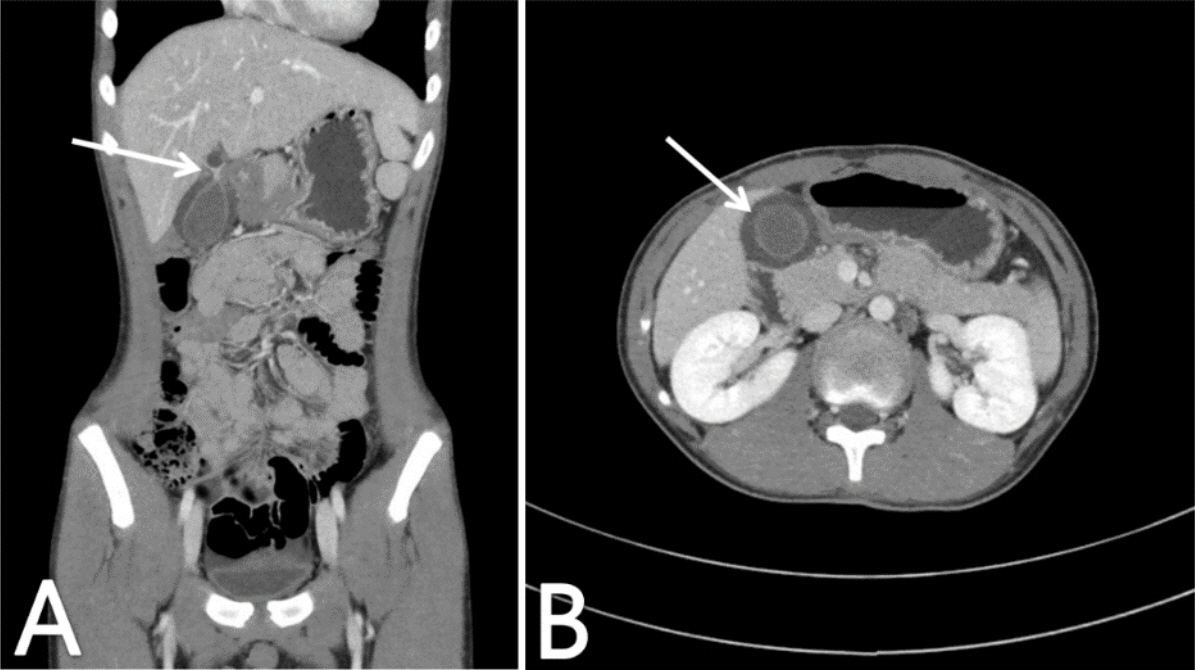Pediatr Emerg Med J.
2022 Jun;9(1):61-64. 10.22470/pemj.2022.00416.
A 13-year-old boy with strangulation of the floating gallbladder by the lesser omentum
- Affiliations
-
- 1Department of Pediatrics, Presbyterian Medical Center, Jeonju, Republic of Korea
- KMID: 2531533
- DOI: http://doi.org/10.22470/pemj.2022.00416
Abstract
- The selection of imaging modality is important in emergency departments because symptoms in children are usually unclear. In children with abdominal pain, differential diagnosis ranges from common diseases to rare entities requiring surgical therapy. Unremarkable findings on routine investigation, such as laboratory tests and plain radiographs, cannot rule out the surgical entities. Close observation and, if needed, further imaging tests are necessary in emergency departments or even in wards for children with recurrent or worsening abdominal pain. We report a rare case of a 13-year-old boy with strangulation of the floating gallbladder by the lesser omentum. This article features the imaging findings of the rare surgical entity.
Keyword
Figure
Reference
-
References
1. Kim WS, Lee JH. Strangulation of the floating gallbladder by the lesser omentum. Soonchunhyang Med Sci. 2020; 26:91–4.
Article2. Juliusson G, Thorvaldsdottir B, Kristjansson JM, Hannesson P. Diagnostic imaging trends in the emergency department: an extensive single-center experience. Acta Radiol Open. 2019; 8:2058460119860404.
Article3. Choi JI. Prospects on the increase of radiological examinations in Korea. J Korean Med Assoc. 2020; 63:136–9.
Article4. Miyakura Y, Sadatomo A, Ohta M, Lefor AT, Sata N, Nishimura N, et al. Floating gallbladder strangulation caused by the lesser omentum: report of a case. Surg Today. 2012; 42:693–6.
Article5. Ueo T, Yazumi S, Okuyama S, Okada Y, Oono T, Watanabe M, et al. Acute cholecystitis due to strangulation of a floating gallbladder by the lesser omentum. Abdom Imaging. 2007; 32:348–50.
Article6. Kohga A, Okumura T, Suzuki K, Yajima K, Yamashita K, Isogaki J, et al. Strangulated gallbladder caused by a tip of the omentum attached to the abdominal wall: a case report. J Surg Case Rep. 2017; 2017:rjx126.
Article7. Morales AM, Tyroch AH. Wandering gallbladder. Am J Surg. 2008; 196:240–1.
Article8. Pu TW, Fu CY, Lu HE, Cheng WT. Complete body-neck torsion of the gallbladder: a case report. World J Gastroenterol. 2014; 20:14068–72.
Article9. Boonstra EA, van Etten B, Prins TR, Sieders E, van Leeuwen BL. Torsion of the gallbladder. J Gastrointest Surg. 2012; 16:882–4.
Article10. Chen L, Baker MD. Novel applications of ultrasound in pediatric emergency medicine. Pediatr Emerg Care. 2007; 23:115–23.
Article
- Full Text Links
- Actions
-
Cited
- CITED
-
- Close
- Share
- Similar articles
-
- Strangulation of the Floating Gallbladder by the Lesser Omentum
- Erratum for: A 13-year-old boy with strangulation of the floating gallbladder by the lesser omentum
- Double gallbladder completely enclosed in a cystogastric fold of peritoneum
- Cystic Lymphangioma of the Lesser Omentum
- Spontaneous Transomental Hernia



